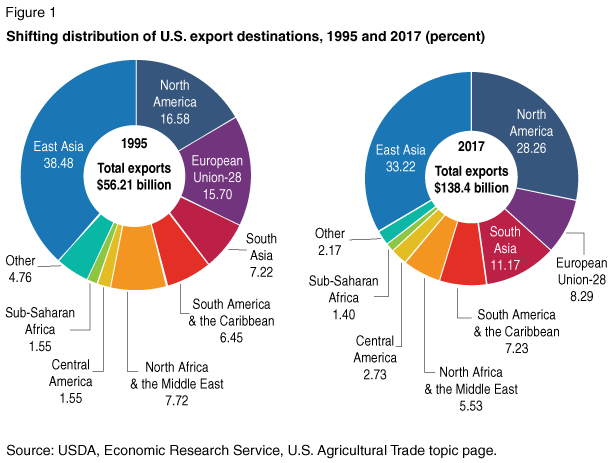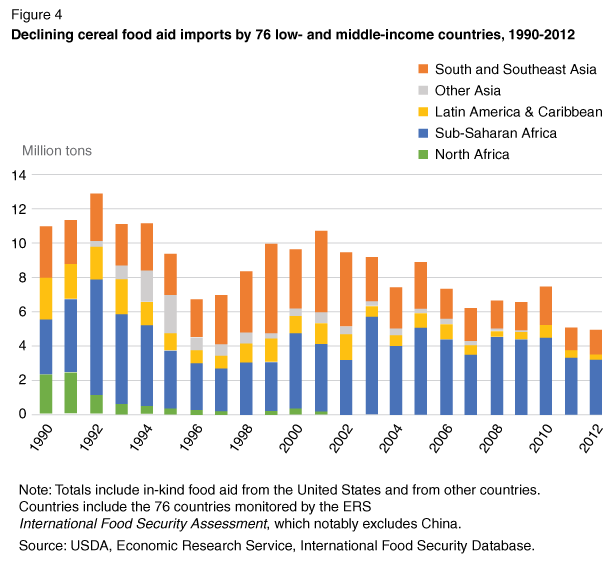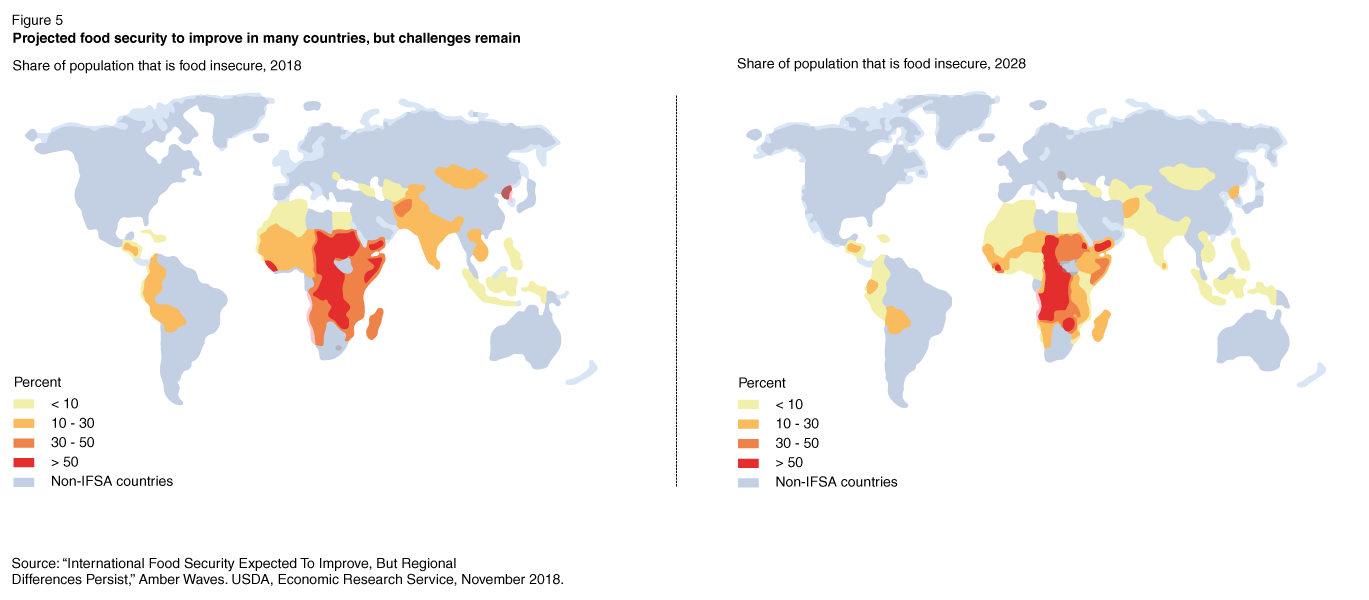Trade: Title III
Focuses on three main areas: (1) emergency and nonemergency food aid administered by the U.S. Agency for International Development (USAID) under the Food for Peace Act; (2) market development and export promotion under USDA-administered programs established under the Agricultural Trade Act of 1978; and (3) other agricultural trade laws, including the Food for Progress program aimed at agricultural and development programs and the McGovern-Dole International Food for Education and Child Nutrition Program, both administered by USDA.
Highlights
The Agricultural Improvement Act of 2018 (2018 Farm Act):
- Consolidates USDA’s four market development and export promotion programs into a new Agricultural Trade Promotion and Facilitation Program and provides the Secretary of Agriculture new flexibility in promoting trade.
- Permits Market Access Program and Foreign Market Development Cooperator Program funding for activities in Cuba, with the restriction that funds are not used in contravention of the policy outlined in National Security Presidential Memorandum 5 of June 16, 2017.
- Expands technical assistance and extension efforts to increase trade and improve global food security.
- Removes minimum commodity monetization requirement (i.e., donated food sold to fund programming) for nonemergency development programs under Food for Peace.
- Requires more detailed annual reporting by USDA and USAID on use of funds by cooperators and implementing parties.
New Programs and Provisions
Agricultural Trade Promotion and Facilitation Program (ATPFP)—With mandatory annual funding of $255 million, or an equal value of commodities owned by the Commodity Credit Corporation (CCC), the ATPFP consolidates USDA’s four market development and export promotion programs (Market Access Program, Foreign Market Development Cooperator Program, E. Kika De La Garza Emerging Markets Program, and Technical Assistance for Specialty Crops) and adds to it the Priority Trade Fund. This new fund provides the Secretary of Agriculture $3.5 million annually to promote trade when the ATPFP’s component programs have applications that exceed available funding. Each of the individual programs in ATPFP maintain unique functions and different allocation levels.
Biotechnology and Agricultural Trade Program—Assists with the removal of nontariff and other trade barriers to U.S. agricultural products produced with biotechnology and other agricultural technologies. The program was originally part of the Food Agriculture and Conservation Act of 1990 and was appropriated $6 million annually from 2002 to 2007. The program lapsed in 2007 and has been re-authorized for lower appropriations of $2 million annually.
Expanded technical assistance and extension efforts include:
- USAID’s Farmer-2-Farmer Program, which provides technical assistance from U.S. volunteers to farmers, farm groups, agribusiness, and other agricultural institutions in low- and middle-income countries to promote improvements in food security and agricultural processing, production, and marketing, is broadened to include selection of seed varieties and plant stocks, knowledge of insecticide and sanitation procedures to prevent crop destruction, use and maintenance of agricultural equipment and irrigation systems, and selection of fertilizers and methods of soils treatment.
- The Borlaug Fellowship, which promotes food security and economic growth by providing training and collaborative research opportunities to fellows from low- and middle-income countries, now explicitly includes the development of agricultural extension services in foreign countries as a purpose.
- The Cochran Fellowship, which provides short-term training opportunities to agricultural professionals from middle-income countries, emerging markets, and emerging democracies—now explicitly includes extension services and regulatory systems governing sanitary and phytosanitary standards as a purpose.
- The International Food Security Technical Assistance provision (Title III) defines “international food security” as “access by any person at any time to food and nutrition that is sufficient for a healthy and productive life.” It authorizes appropriations of $1 million annually to the Secretary of Agriculture to collect information on, and provide technical assistance for, the improvement of international food security.
- The International Agricultural Education Fellowship Program is established, with authorized annual appropriations of $5 million, for U.S. citizens to provide technical assistance to develop agricultural extension and education programs for youths in developing countries.
The 2018 Farm Act removes some minimum requirements for USAID when selling donated food (i.e., monetization) to fund nonemergency programs by recipients. The Act also permits up to 10 percent of funds for local and regional food purchases under the McGovern-Dole program.
The 2018 Farm Act also requires more detailed annual reporting by USDA and USAID on use of funds by cooperators and implementing partners, including calculating a rate of return for each commodity monetized (i.e., sold to fund programming), and economic impact assessments for all modalities of food aid, including local and regional purchase, cash, and vouchers.
The Secretary of Agriculture is directed to include greater tribal representation on trade missions and to increase the inclusion of tribal agriculture and food products in trade-related activities. Goals for measuring tribal inclusion are required, as is a 2-year deadline for reporting USDA’s efforts.
Economic Implications
- The 2018 Farm Act provides mandatory funding for U.S. export promotion programs. U.S. agricultural exports were valued at $138.4 billion in 2017, accounting for 9 percent of all U.S. exports. Destinations for U.S. agricultural exports have shifted (figures 1 and 2). The share of U.S. agricultural exports flowing to Canada, Mexico, and emerging markets in Asia and Latin America rose over 1995-2017. This change reflects the growing share of developing countries in world agricultural trade (figure 3), as well as the effects of multilateral and bilateral trade liberalization.



- The world’s food aid imports by low- and middle-income countries (excluding China) fell between 1990 and 2012 (figure 4), while commercial food imports rose. International food security organizations, such as the United Nations and the World Bank, have promoted flexible modalities of food aid and economic development to combat chronic food insecurity. The amendments to Title III in the 2018 Farm Act eliminate monetization requirements (funding obtained by selling donated commodities) under Food for Peace, include more programs in nonemergency funds accounting, and expand the technical scope and participation requirements for several fellowship programs. Fellowships and technical assistance programs support value chain development that provide opportunities to increase demand for U.S. farm products.


- New modalities of international food aid—including vouchers, local and regional purchase, and cash—are increasingly being employed, as traditional, in-kind food aid imports have fallen. The use of different modalities of food aid can increase cost efficiency and improve response times in emergency situations. The changes in monetization requirements under Food for Peace could free up more commodities to be used in emergency situations. While global food security is projected to improve over the next 10 years (figure 5), emergency needs remain, particularly in conflict areas; which modality is most effective at delivering food aid depends on the scale of the emergency, how markets function, and other factors. The stronger reporting requirements under the 2018 Act are intended to generate more timely and detailed data on the use and impact of aid, making it easier to evaluate and refine food security programs.
